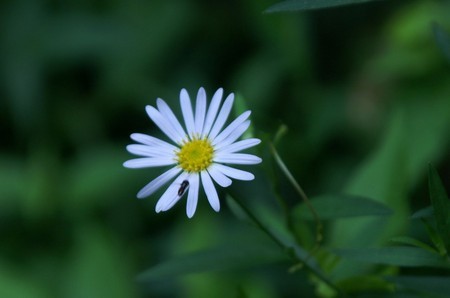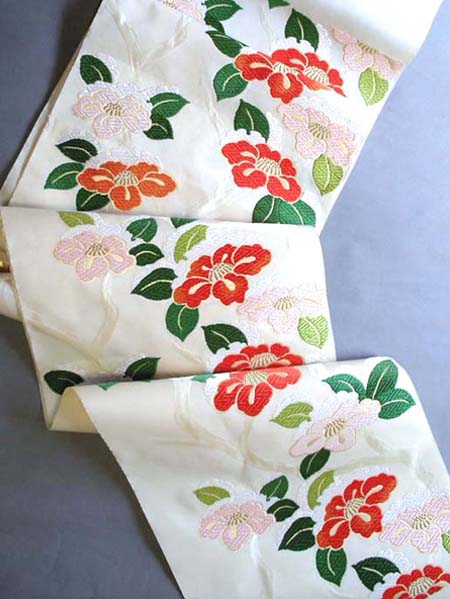
"Flower" in Fujifabric's 1st album, "Fujifabric", is the song which gently strikes our heart with a simple sound of two guitars and Mr. Shimura's breezy vocals following the lyrics in plain words.
When I hear this song, I instantly remember autumn in my hometown, Yamanashi Prefecture, where Mr. Shimura is also from.
In this song, "Flower" is used as an important metaphor to describe the feeling - "Everything has its best time. It cannot enjoy the best time eternally as nothing in this world is permanent. Regardless our feeling, the time passes."
In the traditional Japanese worldview, all of conditioned existence, without exception, is in a state of flux, and this leads to us to feel the transience and impermanence of life especially through the changing of seasons.
The Tale of the Heike is one of the Japanese novels which was inspired by this particular view.
It is also the core of Fujifaburic's songs.

In Japanese language, there is a word, "Kachoufugetsu" (literally means, "flower-bird-wind-the moon") praising the beautiful objects found in the nature, and flowers have been considered to be one of the most crucial elements to express and put some colours in the season.
One of the reasons is thought to be that flowers and blossoms in Japan are very diverse due to distinctive four seasons. In a tropical country, like Thailand, there are many kinds of flowers which are in full bloom all year around, but in Japan, each flower can be seen only in the limited season.
In the world of Haiku, a name of flowers are used as a seasonal reference.


Also in the world of beautiful Kimono (Japanese traditional dress), flowers play an important role.
Japanese people enjoy wearing kimono and obi (the sash worn with kimono), on which the patters of seasonal flowers, birds, and sceneries are dyed or embroidered, and the flowers are the most popular ones among those patterns to express the season.
There is a rule to wear the flower-patterned kimono - the kimono with a seasonal flower always needs to be worn before its actual season comes, and can be worn till the flower is in full bloom in the real nature. For instance, wearing the kimono with pattern of Ume (plum blossoms) in March is too late, and in December is too early.
A profound knowledge of flowers in each season is required.







Let's take a look at flowers in autumn.
In September, flowers referring to Aki No Nanakusa (Autumn Seven Herbs - "Ominaeshi", a yellow-flowered parennial herb of the valerian family, "Obana", Japanese plume grass, "Kikyou", a bellflower, "Nadeshiko", a pink, "Fujibakama", a boneset, "Kuzu", an arrowroot, "Hagi", a lespedeza), a small chrysanth, a dayflower, Mizuhiki-sou.
In October, a big chrysanth, a small chrysanth, maples, ginko leaves, fallen leaves.
In November, a camellia blossom, falling maple leaves, ginko leaves, a sasaqua blossom, winter chrysanth, bamboo, pine tree needles.
Japanese people have felt the beautiful four seasons so attached to life, and this is where Japanese aesthetic comes from.
Which flower did Mr. Shimura refer in the song?
I have written down only autumn flowers, but why did I fell that this is an autumn song?
Let's have a look at the lyrics in details.
The word which expresses the season is the part, "as transient as a flower the colour fading".
The flowers in autumn season don't only fade the colour away, but the petals turn more brownish and look dried up.
They seem like half dried flower.
This "transient flower with the colour fading away" is a metaphor of impermanence explained above.
"Flower hesitating to bloom or not" is stood out even more.
Japanese look at the autumn flowers as "passed its best time" from seasonal and botanical point of view.
There is a sadness that we cannot see fresh colourful flowers for a while as winter is coming soon.

Please fine the part, "replacing the setting sun the rising moon" in the lyrics.
The setting sun looks the most beautiful in autumn in Japan. (The Post on 8th Oct), and as there is a tradional wording, "In the autumn the sun sets as fast as bucket falls in a well.", it really seems like the sun sets so quickly in autumn.
Hearing dogs howling here and there in the distance makes the atmosphere more deserted.
There is no evidence that Mr. Shimura meant to write this song assuming the season is autumn in the song, but I have listened to this song in that way!
Listeners abroad where there is no autumn in the season, it is my pleasure if you can use this information to imagine the background of the song.
This song blooming quietly in the 1st albumn, and this is one of my favorites.
It is full of impressions of Yamanashi Prefecture.
Enjoy listening, Flower by Fujifabric.

No comments:
Post a Comment